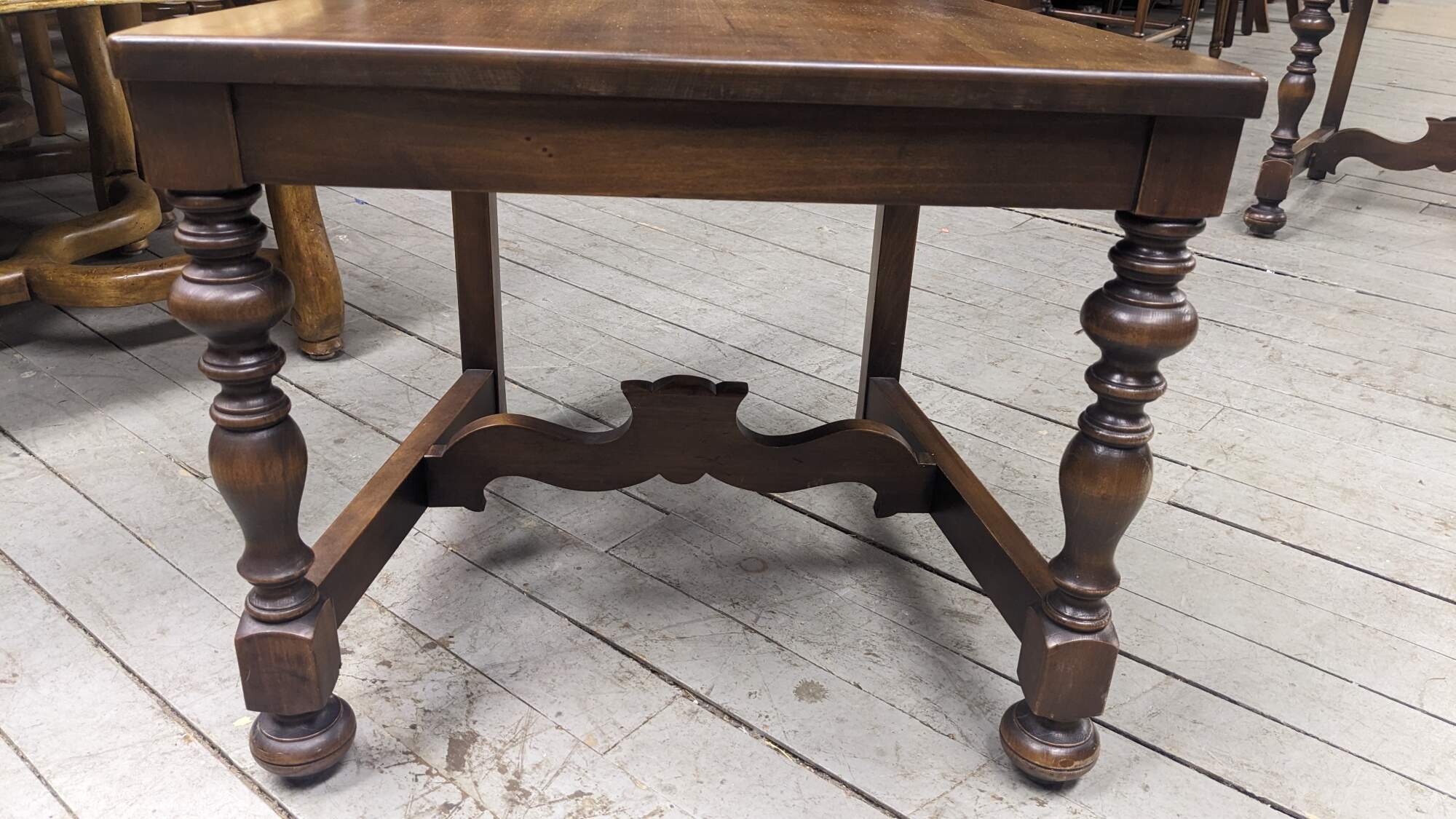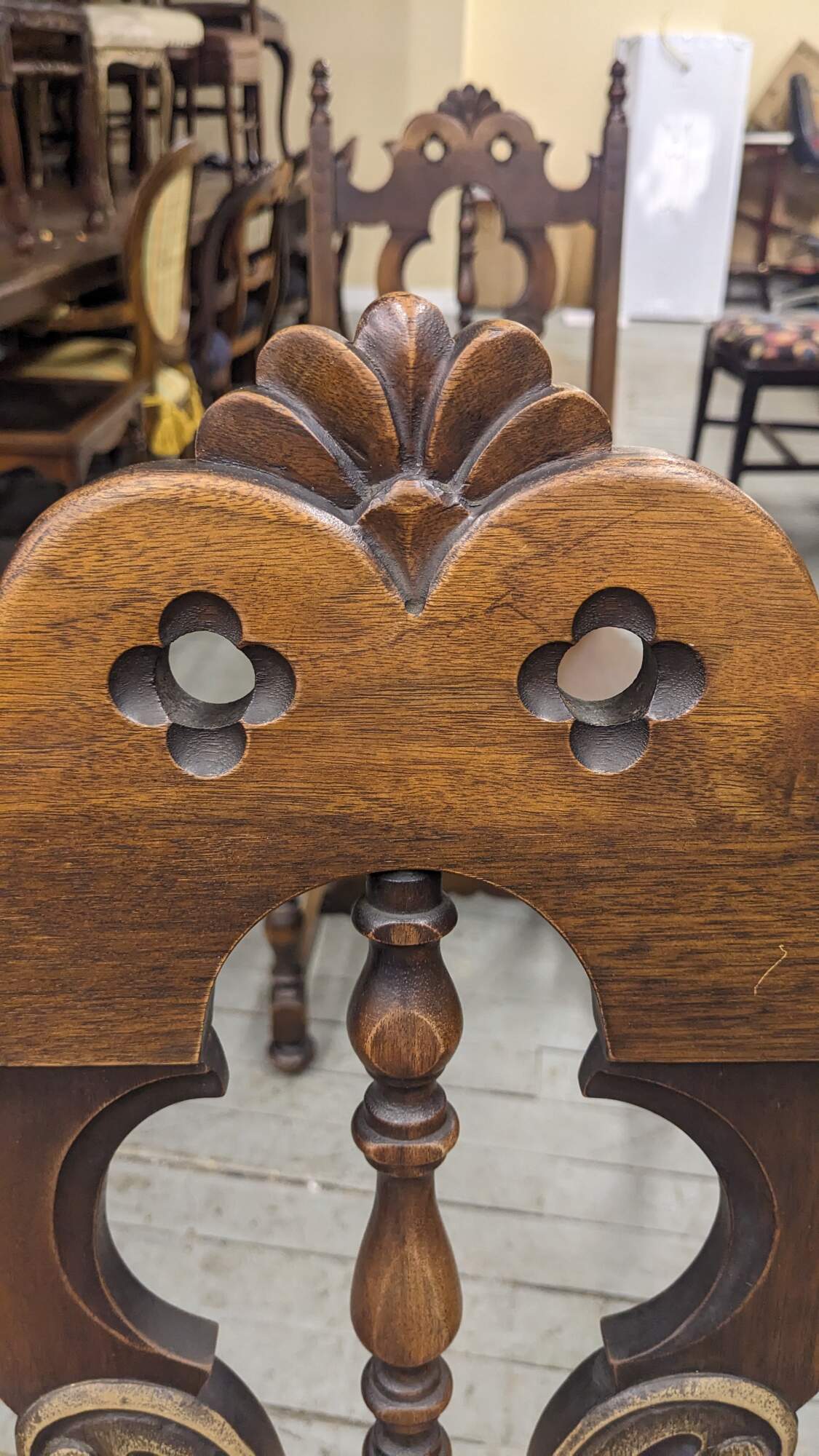
4 Antique Lifetime Furniture Jacobean Gothic Spanish Walnut Dining Chairs Set
Sold
Shipping:
Free Shipping Included
Delivery:
Estimated 2-15 Business Days
Payments:
Credit Card, Check, Cash, PayPal, Apple Pay, Venmo
Returns:
30 Days 100% Money Back Guarantee, Buyer Pays Return Shipping
Description
Set of 4 antique Life Time Furniture Jacobean / Spanish Revival dining chairs. Made of walnut featuring Jacobean styling with turned supports, pierced back, serpentine accents and finials.
In the late 19th century and early 20th century most American furniture manufacturers were fully involved in the production of either Colonial Revival style pieces in accordance with the new taste acquired from the Centennial Exposition of 1876 in Philadelphia or they were running full tilt turning out productions in Golden Oak, the “new” American style. A few were still locked into the old mode of cranking out tiresome Victorian revival styles but that was fading fast.
But there was another pot on the back burner of the furniture stove that was about to boil over and it was being stirred by some names that had long been associated with furniture styles and philosophies. Those names were William Morris (of Morris chair fame), Charles Locke Eastlake, author of “Hints on Household Taste” in 1868, and John Ruskin, art critic, renowned social thinker and an advocate of Christian socialism, all Englishmen. And the pot they were stirring was Arts and Crafts.
The Roycroft community founded by Elbert Hubble on the handwork principles of the old philosophers stumbled on the realities of the market place. Standing ready to pick up the pieces were Gustav Stickley and his famous band of brothers but with the understanding that machinery and factory work were the keys to success, utilizing the basic idea of simplicity espoused by the early founders of the movement. Gustav had been to England in 1897 to meet with Morris. He ultimately became successful when Tobey Furniture of Chicago began to aggressively market his furniture in 1900. And the rest is history so it would seem.
Stickley called his furniture the “Mission” style and it caught on – big time. In no time at all a great number of manufacturers were turning out severe looking, straight line, no frills Mission pieces including Stickley’s brothers in Grand Rapids, Albert and John George under the clever name “Stickley Brothers” who introduced their “Quaint Mission” line of Mission style in1903. A number of other makers who were almost as influential as the Stickley’s were quick to join in like Charles Limbert who presented his “Dutch Arts & Crafts” in 1902 and Paine Furniture Co. of Boston.
You can always tell the pioneers by the arrows in their backs and it didn’t take long for the Mission pioneers to tire of added weight. Gustav sold out (to other brothers) in 1915 and Stickley Brothers began to bail out of Mission as early as 1909.
But as the founders began to abandon the style other so-called second tier manufacturers jumped in. Larkin Soap Company had been making its own Golden Oak style furniture in Buffalo to supply premiums for the soap business and in 1908 belatedly came to discover the Mission style and worked it into the mid 1920s. It may have been responsible for more people being able to afford Mission style furniture than anyone else.
And there was another late comer to the dance with the unlikely name of the Grand Rapids Bookcase and Chair Co. It was formed in 1911 by the merger of Barber Brothers Chair Co and Grand Rapids Bookcase Co., both owned by the Barber brothers, A.A. and J.C. Almost immediately the new company issued a new complete line of Mission style furniture with the name “Cloister” under the trade name “Lifetime.” The Lifetime name had originally been used by the Chair Co. around 1905 for a line of Mission style chairs. Now it was to become a blanket name for the new company that became better known than the actual company name.
The new company’s inventory was classic Mission style with the occasional oddly angled slat or stretcher and it was initially more severe and clunky than even the most austere models turned out by stuffy old Gustav. In short it was the epitome of the movement even if wasn’t as wildly popular as less over bearing examples.
But alas as Stickley Brothers had already discovered the upper end mainstream market place was rapidly turning away from classic Mission, looking for a little artistic relief. Stickley Brothers had stumbled onto good thing with the name “Quaint” and they held on to it. Variations of the name Quaint such as Quaint Tudor, Quaint American, Quaint Furniture of Character and just plain Quaint Furniture were used by Stickley brothers through the late 1920s.
Never one to pass up a good thing when shown, Grand Rapids Bookcase and Chair Co decided to do the same thing with its famous name as had Stickley Brothers. Under the Lifetime trade name lines of furniture such as the Jacobean line of 1913 and the Puritan line of 1917 appeared. Even into the 1920s and 1930s after the Mission style was long departed and the company had turned to heavily carved European revivals, the Lifetime label lingered on. A newspaper ad in 1914 points out the diversity of the company’s Lifetime line. The Grand Rapids Furniture Record Volume 29, December 1914 quotes the company as saying, “Progression is shown in the new designs, comprising suites complete in William and Mary, Queen Anne, Sheraton, Jacobean, Colonial and Mission” – all under the name Lifetime.
While a Lifetime label was used to signify a significant part of the Arts & Crafts/Mission period, it was also used much later and does not guarantee the Arts & Crafts origin of a piece of furniture.
Condition
Good Antique Condition; Gently Used
Dimensions
21.5" x 23" x 43"h










